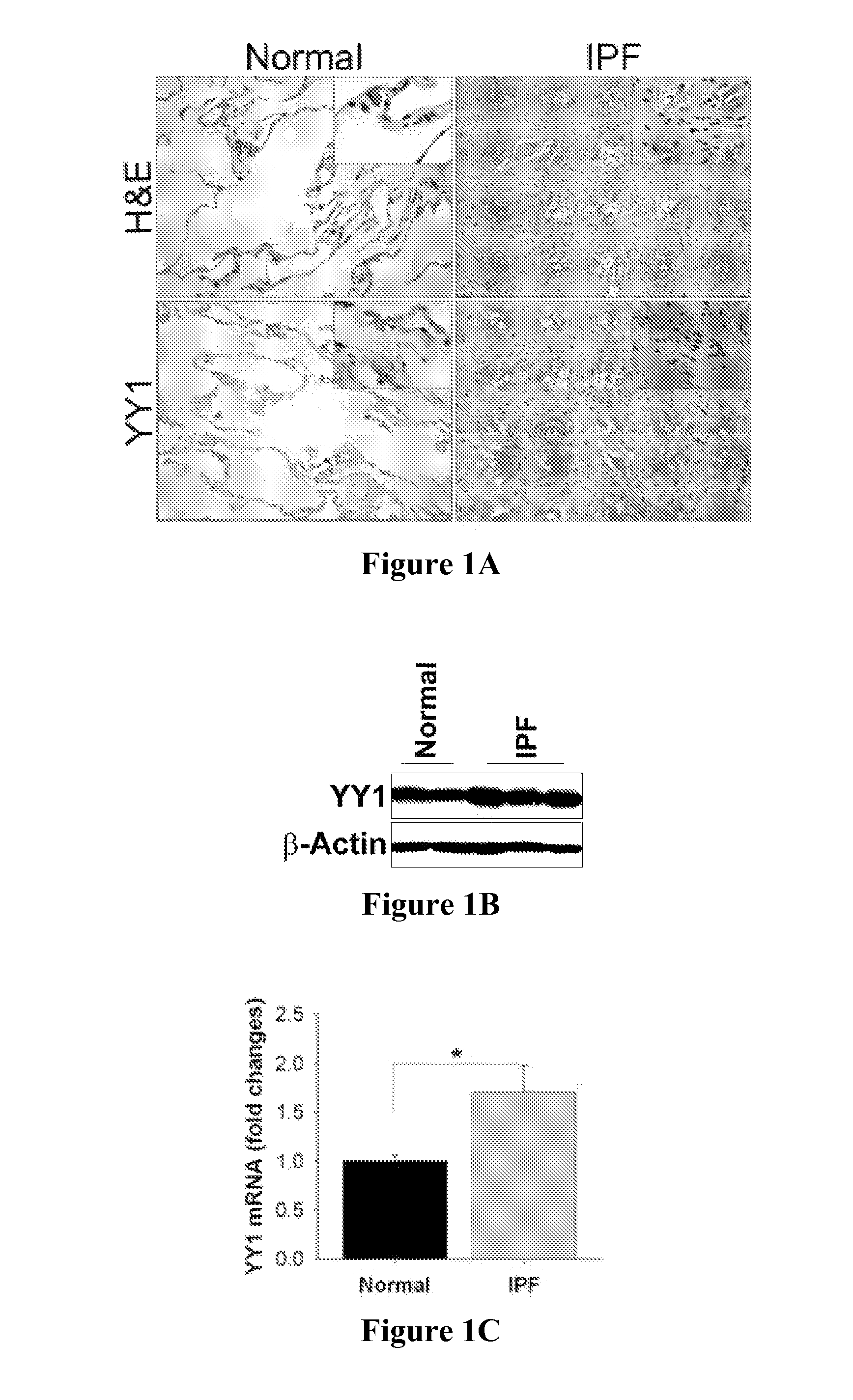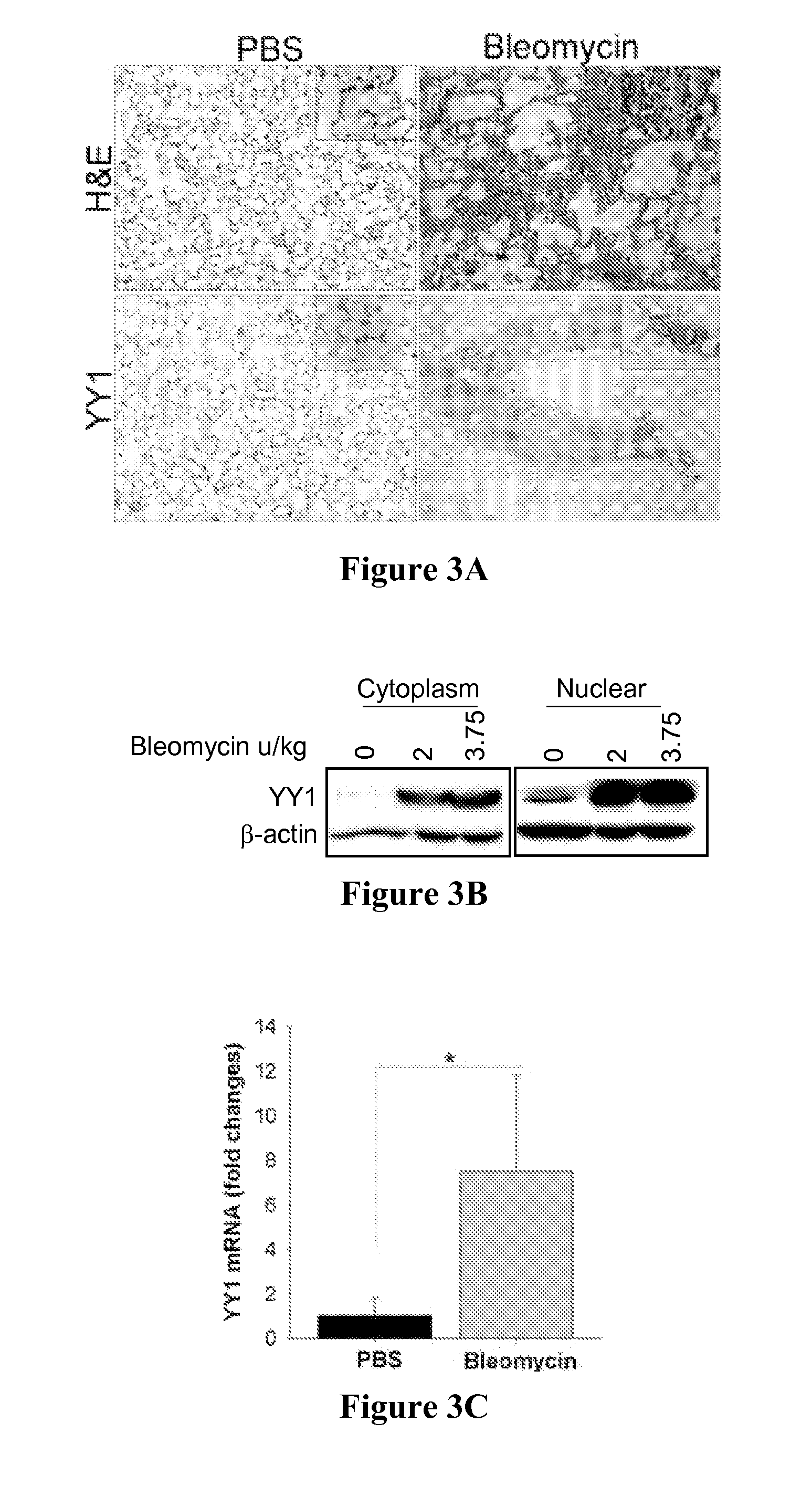Methods of diagnosing and treating fibrosis
a fibrotic condition and fibroblast technology, applied in the field of fibrotic condition diagnosis and treatment, can solve the problems of fibroblast activation, fibroblast activation remains poorly understood, and the precise molecular mechanisms underlying persistent fibroblast activation remain poorly understood, so as to facilitate the development of early diagnostic markers and prevent or reduce disease progression
- Summary
- Abstract
- Description
- Claims
- Application Information
AI Technical Summary
Benefits of technology
Problems solved by technology
Method used
Image
Examples
example 1
Animals and Silica or Bleomycin Administration
[0145]YY1 heterozygotes (YY1+ / −) and conditional knockout YY1 (YY1f / f) mice were obtained from Dr. Yang Shi (Harvard University, Boston, Mass.). All animals were grouped according to age (6-12) or weight (20-35 g). YY1+ / − mice were on a C57BL / 6 background (≧6 generations). YY1f / f mice were on a C57BL / 6 background (4 generations). These mice received 200-300 μg of silica or three units of bleomycin per kg of body weight by intratracheal injection. The background of YY1cc10 is F4 C57BL / 6. All animals were housed under specific pathogen-free conditions at the NIH in an American Association for the Accreditation of Laboratory Animal Care-approved facility. The URMC animal care and use committee approved all experimental procedures.
example 2
Construction of Clara Cell Promoter Driven YY1 (YY1cc10)
[0146]CC-10-driven YY1 (YY1cc10) mice were generated as follows. The plasmid of a rat cc10 promoter (kind gift of Dr. Z. Zhou, Johns Hopkins University) was digested with Xbal-BamHI and the DNA ends were blunted. The murine YY1 gene was digested with BamHI and the DNA ends were blunted. A YY1 insert was subcloned into a blunted rat cc10 plasmid and the plasmid was digested with HindIII and KpnI. The 4 Kb fragment was obtained and injected into zygotes of BJ6 strain to create transgenic mice. Three lines were generated and genotyping was performed using the forward primer 5′-ACTGCCCATTGCCCAAACAC (SEQ ID NO:7) and the reverse primer 5′-GATGGTCTCCACCTCGATCTCATG (SEQ ID NO:8).
example 3
Cell Lines and Isolation of Primary Mouse Lung Fibroblasts
[0147]WI-38 cells (human fetal lung fibroblasts), MLg2908 cells (mouse lung fibroblasts), LL97A cells (human adult lung fibroblasts obtained from a patient with idiopathic pulmonary fibrosis), and MRC-5 (secondary human lung fibroblasts) were all purchased from the American Type Culture Collection. 293FT cells were obtained from Invitrogen. Primary mouse lung fibroblasts were isolated as described in Baglole et al., “Isolation and Phenotypic Characterization of Lung Fibroblasts,”Meth. Mol. Med. 117:115-27 (2005), which is hereby incorporated by reference in its entirety. Briefly, lungs were minced and digested with collagenase and DNase at 37° C. for two hours. After washing with HBSS, isolated cells were collected by centrifugation and plated in T75 flasks in DMEM / F12 (1:1) containing 10% FBS and antibiotics. This was completed in a humidified atmosphere consisting of 5% CO2 and 95% air overnight. Non-adherent cells were rem...
PUM
| Property | Measurement | Unit |
|---|---|---|
| weight | aaaaa | aaaaa |
| body weight | aaaaa | aaaaa |
| densities | aaaaa | aaaaa |
Abstract
Description
Claims
Application Information
 Login to View More
Login to View More - R&D
- Intellectual Property
- Life Sciences
- Materials
- Tech Scout
- Unparalleled Data Quality
- Higher Quality Content
- 60% Fewer Hallucinations
Browse by: Latest US Patents, China's latest patents, Technical Efficacy Thesaurus, Application Domain, Technology Topic, Popular Technical Reports.
© 2025 PatSnap. All rights reserved.Legal|Privacy policy|Modern Slavery Act Transparency Statement|Sitemap|About US| Contact US: help@patsnap.com



